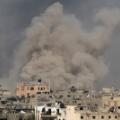While the northern side of the storm will deliver snowy and windy conditions, severe thunderstorms are possible Friday on the southern side -- including for a significant portion of the South and portions of the mid-Atlantic.
Early Friday, before sunrise: Parts of Arkansas, eastern Texas and northwestern Louisiana, including Shreveport, have an enhanced risk of severe storms, or a Level 3 of 5, according to the Storm Prediction Center.
A slight risk for severe storms, or Level 2 of 5, exists early Friday for a wider area, from eastern Texas to western Mississippi. The main threats there are tornadoes, strong gusts and large hail.
Friday, during the day: An enhanced risk of severe storms, or a Level 3 of 5, exists for a large portion of northern Mississippi and part of western Alabama, according to the Storm Prediction Center. A slight risk for severe storms, of Level 2 of 5, exists for a wider portion of the Southeast from the rest of Mississippi to much of the Carolinas, including the areas of Birmingham, Alabama; Memphis, Tennessee; and Charlotte and Raleigh, North Carolina.







